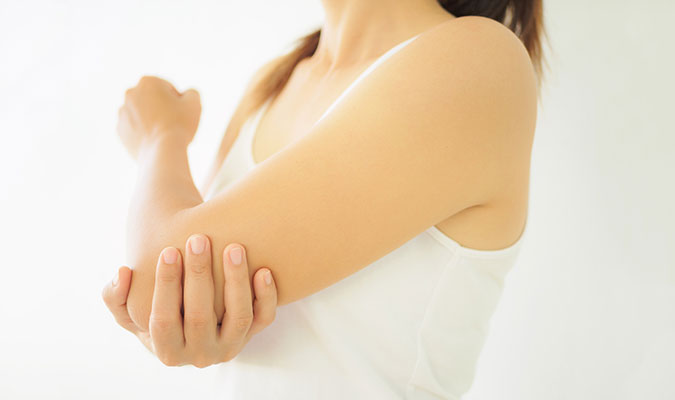Just like most joints in your body, your elbow can suffer from overuse, especially from repetitive motions where you move your elbow and arms in the same direction over and over again. One condition that we see frequently in our patients is called lateral epicondylitis, or more easily pronounced, tennis elbow. Despite its name, it doesn’t come strictly from playing tennis.
What Is Tennis Elbow?
Tennis elbow is caused when the tendons surrounding the elbow become inflamed. Your elbow joints are composed of an upper arm bone called the humerus, as well as two bones in your forearm called the radius and ulna. There are also smaller bony bumps called the epicondyles and lateral epicondyle. In addition to these bones, your elbow also contains muscles, ligaments, and tendons that help hold those bones together and allow for freedom of movement in the arm and elbow and prevent your bones from rubbing against each other. When your elbow is operating as it should, you should have no problem with pain or inflammation and should be able to perform these tasks. Tennis elbow may present when you begin to use your elbow with frequency using the same motion, notably a repeated contraction of your muscles when you raise your hand and wrist, utilizing the forearm. This repetitive motion can cause small tears in your forearm muscles, resulting in the pain and inflammation that accompanies tennis elbow.
Who Else Gets Tennis Elbow?
The average age of diagnosis for tennis elbow is between ages 30 and 50. In addition to being seen frequently in tennis players, it is also seen in plumbers, painters, and carpenters, as they are also likely to continue using up and down motions of the elbow in order to complete their jobs. Other occupations that require repetitive heavy lifting which may lead to tennis elbow include butchers, auto workers, and even cooks.
How Is Tennis Elbow Diagnosed?
Tennis elbow doesn’t typically come on quickly, rather it begins as mild pain and tends to get worse over a period of weeks or months. It typically presents with a burning sensation in the elbow as well as weakened grip strength in the affected hand. It will worsen when you make the repetitive motion that is typically the cause of the injury.
This condition is usually diagnosed through a thorough patient history, including physical activity and participation in sports or other tennis elbow-prone activities. You may also need an X-ray or MRI to determine if there is something else that may be the cause.
What Is The Best Course Of Treatment For Tennis Elbow?
Tennis elbow is generally treated without surgical intervention. There are a number of medications available to aid in healing, including steroid injections or pain and swelling reducing medications. Other treatment options include physical therapy, rest and avoidance of the activity that lead to the condition, or braces that can help your elbow rest. If these non-surgical options don’t treat your condition, there are also a number of surgical options available, typically followed by physical therapy or rehabilitation.
If you have been experiencing the symptoms of tennis elbow and are interested in seeking treatment to relieve your pain and begin the healing process, it’s time to book an appointment with Capital Ortho for an evaluation.

